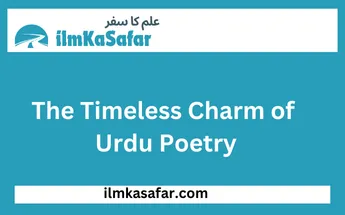Table of Contents

Understanding Urdu Poetry:
On a recent Visit to the Origins of South Asian Literature
If you are Want to read Urdu Poetry you are landing on Right Place. Urdu is not only the writing on paper but it is the door to the heart of the South Asian peoples, it is the way of presenting feeling, emotions, passion and the beauty. Having the music in its chosen rhythm, ability to provoke feelings and even to create a powerful philosophy – Urdu poetry remains dear to generations’ hearts. This blog post aims to give reader an insight into what Urdu poetry is, a brief history into the roots of the Urdu poetry and the various forms and uses of Urdu poetry.
Overall, there is the importance of the idea that:
Introduction to Urdu Poetry
The Pakistani inhabitants are known to be quite fond of poetry, especially the poetry in the Urdu language — an art form that comes from the South Asia region. Over many years it has worked as a means of communication of the individual and cultural story telling that is more than language in broad sense of the word as it reflects on the human experience. Metaphor laden, and extremely poetic, Urdu poetry gives voice to emotions, grappling with themes as diverse as love and, mysticism, and philosophy. And its ability to be musical has enabled it to store narratives and emotions, often bundling individuals and pop, culture values.
What is Urdu Poetry?
There is certain kind of flavor – rhythmic flow, melody and vibrant picture – that is associated with Urdu poetry. Most of them are quatrains or fours lines a kind of misra each line is extremely rhythmic and there’s a strong emphasis of the sound forming a perfect symmetry with meaning. Figurative language and imagery are employed, even in references which make ordinary complex phrases of love, hopelessness, happiness and rumination. Such devices help Urdu poets-pack too many significances in few words – turn out every verse into an embodiment of sentiments & ideas.
Key characteristics of Urdu poetry include:
•Musicality and Rhythm: Urdu poetry at many places rhyme hence one can easily chant the verses, which adds music to the printed word. The lyrics themselves along with the placement of refrains gives the song a tune and makes it emotionally richer.
•Rich Use of Metaphors and Symbolism: Urdu poetry especially of the romantic era has complex use of symbols associated with nature, spirituality, and human feelings to provide for more than one meaning.
•Emotional Depth and Thematic Diversity: Urdu poetry consists of numerous topics which include romantic passion and spiritual devotion and freedom fight and existential questioning.
History of Urdu Poetry
It would be important to assert that Urdu poetry has its roots in Indian subcontinent as early as with the decades of Muslim invasion when people’s dialects and Persian literature started mingling. The brought into contact Persian, Arabic, and regional languages which nurtured Urdu and a new form of poetry.
Evolution Through the Ages
1. Persian Influence: Urdu poetry in its early stage drew a lot from Persian literature as most poets were Persian influential in their writing. That is why the greatest influence of other languages on Urdu poetry was exerted during the early stages of its development, and the chief sources of imitation were the masters of Persian poetry in regard to style, topics, and types of poetic works.
2. Mughal Patronage: The Mughals saw the emergence of Urdu poetry as a few others poems from the British era. Court elites and consumers of art, the Mughals, inspired poets to-container write in Urdu. Finally, Ghazal Sahar developed as this era also corresponds to the embellishment of classical Urdu Poetry.
3. Colonial Period: Urdu poetry in British period, adopted new subjects, social reform and rebellion became part of the genre. Mirza Ghalib and Allama Iqbal wrote poetry and most of it could be assumed that it was the voice of the masses.
4. Post-Independence Era: After the partition of India in 1947 Urdu poetry also went by undergoing through the socio political transformation of that era. Such reformist poets as Faiz Ahmed Faiz rose to the role of spokes persons of the voiceless in society and champions of social justice.
Influential Urdu Poets
•Mirza Ghalib: Being a poet of internal locutions, Ghalib’s poetry is well acclaimed for the philosophical substance as well as dark and sad sentiments of the verses.
•Allama Iqbal: Iqbal is a great philosopher and visionary, his poetry lead towards social reformation and the creation of liberation movements.
•Faiz Ahmed Faiz: This makes Faiz’s poetry more famous for its romantically defiant tone and its demand for oppressions end.
Types of Urdu Poetry
It is important to know that Urdu poetry is not a homogeneous line of poetry but different forms of poetry that were followed different concepts and physical structures. Here are some of the most significant types of Urdu poetry:
1.Ghazal
Description and Structure: The Ghazal is a collection of shers, which can be read as individual couplets; however, they are joined together as each shayari will address the mere topic in unison. Classically, ghazals are love songs that have touched and revolve around love and longing that is mostly unreciprocated, and Spirituality.
Themes: Frequent themes of the ghazal include love, separation and union between lovers, and the love of the lover and the beloved in cosmic love with God or their sufficient substitute, and while themes and the development of ideas are brought home strikingly with major shivers, the type of affective movement privileged in the ghazal is understated.
2.Nazm
Difference from Ghazal: While the Ghazal has a well-defined pattern the Nazm is comparatively more flexible in terms of form and content.
Flexibility in Structure and Themes: It can ranged from addressing issues affecting the society, to giving voice to the poet’s thoughts and feelings, allowing Nazm to offer great versatility for poets.
3.Qasida
Historical Context: Derived from Arabic literature, the qasida was in the past used to either commend or condemn. In Urdu it was employed as what means to praise one’s benefactors and what to taunt one’s enemies.
4.Marsiya
Elegiac Form: Marsiya is the mourning and questioning, narration of the event at Karbala for the martyr of Imam Hussain. The verses are passionate, which are tied with sorrow and respect emotions.
5.Rubai
Structure and Focus: Rubai is a quatrain, usually offering a piece of wisdom or a joke. It is inclined to the cyclical aspect of life and contain spiritual messages.
Importance of Urdu Poetry
Urdu poetry possessed an important cultural value with being solely responsible for preservation of South Asia cultures and values for generations. Thus, it plays not only an aesthetic function of reading pleasure but suggests historical and identity motifs, as well as social transformations.
•Cultural Significance: Urdu poetry is a part of the heritage of the South Asian subcontinent as it has been used historically as the way of the story and value telling.
•Influence on Modern Literature and Music: In tune with the music, contemporary Urdu poetry has attained a place in different ghazals and especially Bollywood song.
•Role in Social and Political Discourse: The Urdu poets have come up with extraordinary great work which sometime reflect the pains and agony of a nation and at other a call to reform and fight for the rights. Shall we name a few – poems of Faiz Ahmed Faiz and others remain classic in politics and cultural nourishments.
•Personal Identity and Emotional Connection: This is true because Urdu poetry allows people to read emotions and find some sort of comfort within string of words that shares their own feeling with them.
Conclusion
It has been seen that Urdu poetry is enriched with tradition and still seems contemporaneous. That is why people turn to it nowadays, to find in concepts beauty, depth, meaning and bonding with other like-minded people. In either case, it is also beneficial for people to venturedeep in the sea of feelings and spirit of culture, if one needs literature then Urdu poetry forms a vast ocean. The great poets like Ghalib, Iqbal, Faiz etc enlighten us with the exquisite message that lies into the worlds and how we should respect this tradition of words.
Some Frequent Question People Ask About Urdu Poetry
1. Urdu poetry is unique as:
In models and symbolism, Urdu poetry is unique because of its musically influenced language. In the world of literature its lyrical quality, its passion, its versatility in its subject matter from love and death to civil rights and metaphysical concerns.
2. Which are the most recognized personalities of Urdu poetry?
Some of the most influential poets of Urdu have been Mirza Ghalib for his great ghazals, Allama Iqbal for his thoughts creating revolutionary poetry and Faiz Ahmed Faiz for his charged up and socially conscious poetry.
3. What is the classification of Urdu poetry?
The major types of Urdu poetry include Ghazal which has love and mysticism as its main subjects; Nazm which is praised for its versatility in term of themes and presentation; Qasida which has been employed in the past for both praise and ridicule; Marsiya which is lamentation poetry; and Rubai which is a form of poetry consisting of four lines in which wisdom and humor are usually highlighted.
4. What kind of changes can be seen in the course of developing Urdu poetry?
As geographically connected to the Persian literature, Urdu poetry has grown due to the patronage of the Mughals and got significant growth as well as changes in the colonial and post independent India. Every age had new inventions, and played with the close relationship with the contexts of new age society.
5. Why is the Urdu poetry significant in cultural interaction?
Urdu poetry has a very important cultural importance in South Asian region as it forms part of culture and passes on culture and histories. It also plays a significant role in literature, music, films, and social and political life; it is advocacy and identity.
If you want to get more notes and educational material Visit our Website
For more English Literature Notes Click here to Visit this Website
If You Want to get Free Translated Pdf Books of foreign Writer Visit Here.


